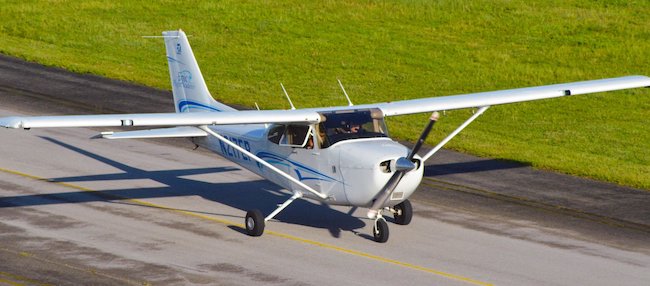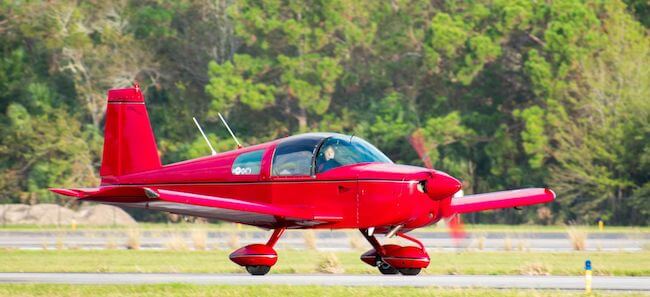Above: Maneuverability and handling characteristics vary from aircraft to aircraft. Pictured here is Captain Judy Rice in her AA1A.
Captain Judy’s Corner: Love at First Flight – Handling Characteristics Make Every Aircraft Unique
Aircraft handling characteristics are important. I initially trained in a docile Cessna 150 (C150) and a spunky Piper Tomahawk. I appreciated the C150’s stability and enjoyed the Tomahawk’s maneuverable handling characteristics. Shortly after completing my private pilot check ride, I noticed a cute little airplane practicing take-offs and landings. Looking to increase my experience, this looked to be a fun airplane to fly. I inquired at the airport office regarding this mysterious airplane.
Three pilots owned the Grumman AA1A. One of the owners offered a flight and mentioned it was for sale. The AA1A’s light controls and quick responses proved love at first flight! Any more than a fingertip on the control yoke or light pressure on the rudder pedals would provide dramatic results. The airplane’s roll rate was impressive and capable of tight turns in the air and on the ground. The pilot-owner explained, “The disadvantage of such a responsive airplane is the constant attention required for maintaining altitude and airspeed. This is definitely not a hands-off airplane on long cross-country flights.”
After numerous aircraft flying experiences, I found my world flight aircraft, the Citation Mustang, the perfect cross-country design. The jet cruised easily at FL350 (35000 feet) with little or no control inputs. Its technology was great. When a gust of wind knocked the jet around, it resumed the correct flight path with little input. This Very Light Jet (VLJ) was very stable with excellent fuel economy. Limited range and payload with a maximum range at 1300 nautical miles and payload 800 pounds – only slightly greater than a Cessna 182 – were its only disadvantages.
What made the Grumman handling characteristics so different from the Cessna, the Piper, or the Citation Mustang?
Engineers place consideration on stability and maneuvering requirements based on the aircraft’s mission. Each aircraft handles differently because of built-in design features. The C150 was slow, stable, and easy to control for flight training purposes, whereas the Citation jet was much faster. It was also easy to control and more stable. The Grumman was quick to react and required constant attention, while the Tomahawk was somewhere in-between with quick handling and neutral stability.
A desirable training or cross-country airplane has design features that allow for controllability and stability. If a gust of wind disturbs a stable airplane, it rights itself with little input by the pilot. Oppositely, maneuverable aircraft have design features with instability. When the pilot makes a control input, the aircraft responds with a dramatic change in attitude and flight path.
Can stability issues prevent a pilot from flying?
Some aircraft are designed to be so unstable that it is not possible for a pilot to fly. These aircraft are designed with stability augmentation systems assisting pilot inputs by using computers and automatic controls. Some jet transport aircraft save weight by having a vertical stabilizer smaller than what is required for stability. In these aircraft, engineers connect an autopilot to the rudder performing the aerodynamic directional stability functions of a larger, heavier vertical stabilizer. Computerized autopilot systems make these aircraft controllable, as well as increase stability.
Stability design features are grouped into two categories: Static and Dynamic. Static stability is the initial tendency of an aircraft to return to its original flight position when it’s disturbed. Dynamic stability is how an airplane responds to a disturbance over time.
Positive static and dynamic aircraft are designed to maintain consistent flight conditions and recover from disturbances that minimize pilot workload. The C150 and the Citation jet have positive static and dynamic stability. Epic’s fleet of Cessna 172s are positively static and dynamic stable.

The maneuverable Grumman AAIA has more negatively Static and Dynamic stability than neutral or positive resulting in overall lower stability and high stall speeds. The most notable aircraft with negatively Static and Dynamic design is an extremely maneuverable supersonic fighter called the X-29 and was controllable only by a digital flight control system.
Longitudinal, lateral, and directional design features determine if an aircraft is either positive, neutral, or negative static and dynamic stable.
Longitudinal stability is a design feature that resists pitching motion when an aircraft’s flight path is disturbed. The aircraft will return to the original flight attitude with little or no pilot corrections. Longitudinal stability design features include:
- Location of the main wings position in relation to the Center of Gravity (CG). CG is an imaginary point which the aircraft would balance.
- Location of the horizontal tail surfaces in relation to the CG
- Area or size of the empennage (tail surfaces)
Laterally stable aircraft resist the rolling motion by design. When a gust of wind causes one wing to become lower or higher than the other wing, a laterally stable airplane will right the aircraft with little input from the pilot. Laterally stable features involve wing designs and characteristics such as: dihedral, sweepback, keel effect, and weight distribution of fuel in the wings.
Directional stability allows an aircraft to resist a sideways motion when disturbed by a gust of wind, called yaw. The area of the vertical stabilizer reacts as a weather vane or arrow’s fletching pointing the aircraft’s nose into the relative wind. To discover more about stabilities and design features, watch Epic’s video on stabilities.
Finding the best engineering solution for a given design requires a delicate balance between many factors such as weight, strength, cost, performance, and safety. The strongest design might be too expensive. The safest design might be too heavy. An engineer’s final design is a compromise between all considered objectives.
And whatever happened to that cute little Grumman AAIA airplane? After 25 years, I continue to love it with each flight!


Read more articles by Captain Judy Rice!

